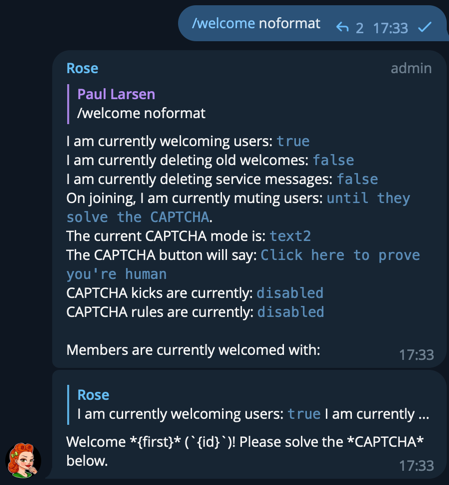Welcomes
Rose's ability to welcome users to your group chat not only is polite, but it is an easy way for you to provide you users with some basic information about your chat (such as rules, required info, etc.).
Enabling Welcomes
To get started, you'll want to actually enable your welcomes. In order to enable welcomes, you will need to issue either of the following commands
/welcome on
Disabling Welcomes
If you decide you'd like to disable welcomes, simply issue either of the following commands
/welcome off
Customising Your Welcome Text
While the default welcome text may be fine for some users, most of you probably want to customise your welcome messages to say something about your group chat. Or you may even want to have your welcomes have a different feel to them. We'll go over customising your welcomes below.
Setting A Custom Welcome
We can set a custom welcome message by issuing the following command, where means the message you want Rose to say:
/setwelcome <message>
Any text you enter after the command will become part of your welcome message. Formatting syntax is also supported in this message.
So, for example, if you wanted to have a message that says "Hey there John! Welcome to Rose Support!", you enter the command like below:
/setwelcome Hey there {first}! Welcome to {chatname}!
Using Stickers Or Media As A Welcome
You can also use stickers or other attachments as part of your welcome messages. In order to do this, you'll need to issue the /setwelcome command as a reply to the sticker or other attachment (such as a sticker or photo). The usage is the exact same as the normal usage, simply issue the below command as a reply to the attachment:
/setwelcome <message>
The "message" portion of the command in this case would add a caption to the image.
Example
Let's say someone posted an image that you want to use as your welcome message, and you wanted to also have a caption for the image saying "Welcome to the group, please look at this picture!", you'd simply reply to the image with the below command:
/setwelcome Welcome to the group, please look at this image!
If you wanted to set the welcome to ONLY be the picture, then you'd simply reply to the image with the /setwelcome command and no arguments, like shown below:
/setwelcome
Note
Stickers cannot have captons added to them. Telegram only allows stickers to be sent by themselves, so you cannot add any sort of caption or message to a sticker-based welcome.
Reset Welcome Text
At any time, you can reset the welcome text to the default string. After issuing the below command, Rose will welcome users with this standard welcome: "Hey there {first}, and welcome to {chatname}! How are you?"
/resetwelcome
Viewing Your Set Welcome
You can also view what the current welcome in your group chat is set to, in case you need to reference it or perhaps copy and paste it for use in another one of your group chats. There are two ways you can view what your chat's currently configured welcome is.
View Welcome (Formatted)
This option is the standard way to view a welcome. You can view the welcome exactly as it's displayed to users. What this means is that if you have any buttons or markdown in your welcome message, it will display it with those buttons or formats. You can do this but issuing the /welcome command without any arguments:
/welcome
The result will be a message like this:

View Welcome (Unformatted)
With this option, you can view the raw welcome message. What this means is that any buttons or markdown present in your welcome message, it will display the code for these. For example, if you had the word "rules" written with italics in your welcome message, then instead of showing you italic text, the viewed message would show "_rules_" instead. You can view this raw output by issuing the /welcome command with the noformat argument, like shown below:
/welcome noformat
The result will be a message like the below. This type of output helps make things easier if you need to edit your welcome:
